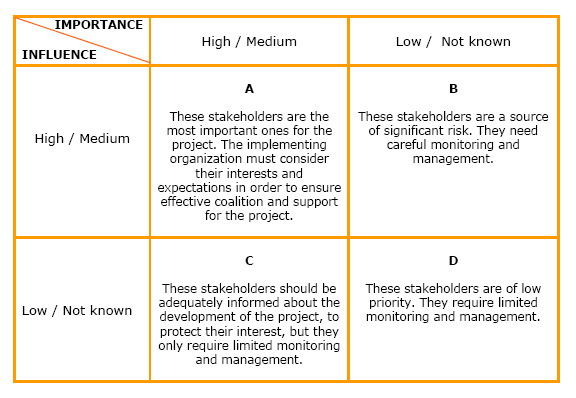Difference between revisions of "Stakeholder Analysis"
From Learning and training wiki
| Line 1: | Line 1: | ||
| − | {{Term|STAKEHOLDER ANALYSIS|The identification of a project's key [[Stakeholders|stakeholders]], an assessment of their interests and the ways in which those interests affect project viability. A basic premise behind stakeholder analysis is that different groups have different concerns, capacities and interests, and that these need to be explicitly understood and recognized in the process of problem identification, objective setting and strategy selection. The key questions asked by stakeholder analysis are "Whose problems or opportunities are being analyzed" and "Who will benefit or loose-out, and how, from a proposed project intervention"? The ultimate aim being to help maximize the social, economic and institutional benefits of a project to target groups and ultimate beneficiaries, and to minimize its potential negative impacts, including stakeholder conflicts. A stakeholder analysis develops a strategic view of the social environment in which a project will be implemented, thus it is usually the first step in building the relationships needed for the success of a project. A stakeholder analysis can be undertaken throughout all the stages of a project cycle. It can be used to: | + | {{Term|STAKEHOLDER ANALYSIS|The identification of a project's key [[Stakeholders|stakeholders]], an [[Assessment|assessment]] of their interests and the ways in which those interests affect project viability. A basic premise behind stakeholder analysis is that different groups have different concerns, capacities and interests, and that these need to be explicitly understood and recognized in the process of problem identification, objective setting and strategy selection. The key questions asked by stakeholder analysis are "Whose problems or opportunities are being analyzed" and "Who will benefit or loose-out, and how, from a proposed project intervention"? The ultimate aim being to help maximize the social, economic and institutional benefits of a project to target groups and ultimate beneficiaries, and to minimize its potential negative impacts, including stakeholder conflicts. A stakeholder analysis develops a strategic view of the social environment in which a project will be implemented, thus it is usually the first step in building the relationships needed for the success of a project. A stakeholder analysis can be undertaken throughout all the stages of a project cycle. It can be used to: |
| Line 9: | Line 9: | ||
| − | Conducting a stakeholder analysis can draw out the interests of stakeholders in relation to the problems which the project or programme is seeking to address or the purpose of the project.<ref>[DFID, Overseas Development Administration.Guidance Notes on how to do a Stakeholder Analysis of Aid Projects and Programmes. London, 1995.]</ref> In evaluation, stakeholder analysis is conducted in order to identify and people, groups and institutions that may influence directly the evaluation; anticipate the kind of influence these groups may have on the evaluation and; build early support for the project or programme as well as reduce possible obstacles to their successful implementation.<ref>Imas Linda G. Morra, Rist C. Ray. The Road To Results; Designing and Conducting Effective Development Evaluations pp.495. The World Bank, Washington DC, 2009.</ref> | + | Conducting a stakeholder analysis can draw out the interests of stakeholders in relation to the problems which the project or programme is seeking to address or the purpose of the project.<ref>[DFID, Overseas Development Administration.Guidance Notes on how to do a Stakeholder Analysis of Aid Projects and Programmes. London, 1995.]</ref> In [[Evaluation|evaluation]], stakeholder analysis is conducted in order to identify and people, groups and institutions that may influence directly the evaluation; anticipate the kind of influence these groups may have on the evaluation and; build early support for the project or programme as well as reduce possible obstacles to their successful implementation.<ref>Imas Linda G. Morra, Rist C. Ray. The Road To Results; Designing and Conducting Effective Development Evaluations pp.495. The World Bank, Washington DC, 2009.</ref> |
Revision as of 11:28, 25 July 2011
| The identification of a project's key stakeholders, an assessment of their interests and the ways in which those interests affect project viability. A basic premise behind stakeholder analysis is that different groups have different concerns, capacities and interests, and that these need to be explicitly understood and recognized in the process of problem identification, objective setting and strategy selection. The key questions asked by stakeholder analysis are "Whose problems or opportunities are being analyzed" and "Who will benefit or loose-out, and how, from a proposed project intervention"? The ultimate aim being to help maximize the social, economic and institutional benefits of a project to target groups and ultimate beneficiaries, and to minimize its potential negative impacts, including stakeholder conflicts. A stakeholder analysis develops a strategic view of the social environment in which a project will be implemented, thus it is usually the first step in building the relationships needed for the success of a project. A stakeholder analysis can be undertaken throughout all the stages of a project cycle. It can be used to:
|
Step by Step
Stakeholder MatrixA stakeholder matrix allows for stakeholders to be plotted against different variables, taking into consideration their importance and their level of influence in the project. [5]
Job Aid |
References
- ↑ [DFID, Overseas Development Administration.Guidance Notes on how to do a Stakeholder Analysis of Aid Projects and Programmes. London, 1995.]
- ↑ Imas Linda G. Morra, Rist C. Ray. The Road To Results; Designing and Conducting Effective Development Evaluations pp.495. The World Bank, Washington DC, 2009.
- ↑ www.landcareresearch.co.nz (23 July 2008), www.panda.org (23 July 2008); Aid Delivery Methods - Project Cycle Management Guidelines, European Commission, 2004
- ↑ www.euforic.org (14 August 2008), www.landcarersearch.co.nz (14 August 2008), www.who.int (14 August 2008), Project Cycle Management Guidelines, European Commission, 2004
- ↑ www.dse.vic.gov.au (14 August 2008)www.who.int (14 August 2008)
